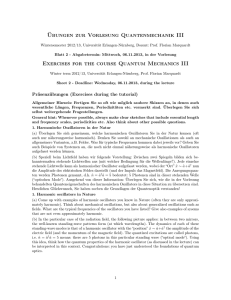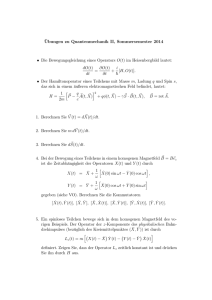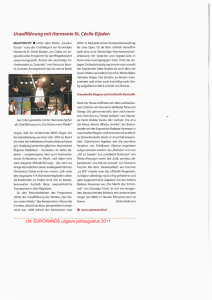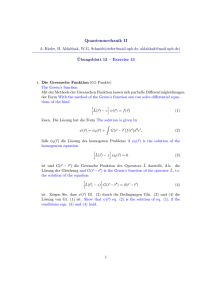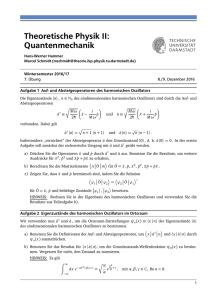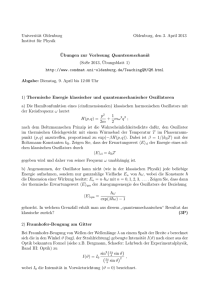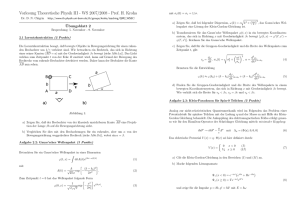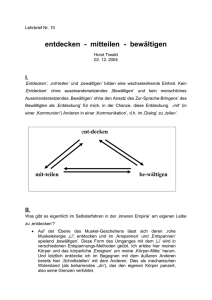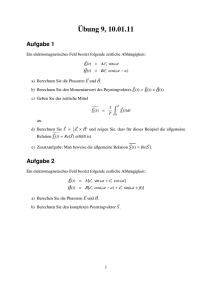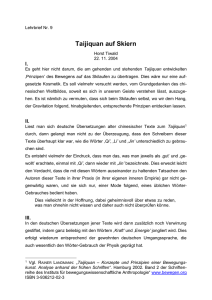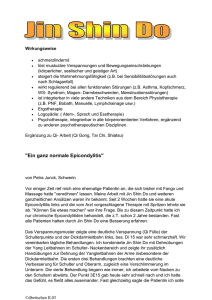Blatt_13
Werbung
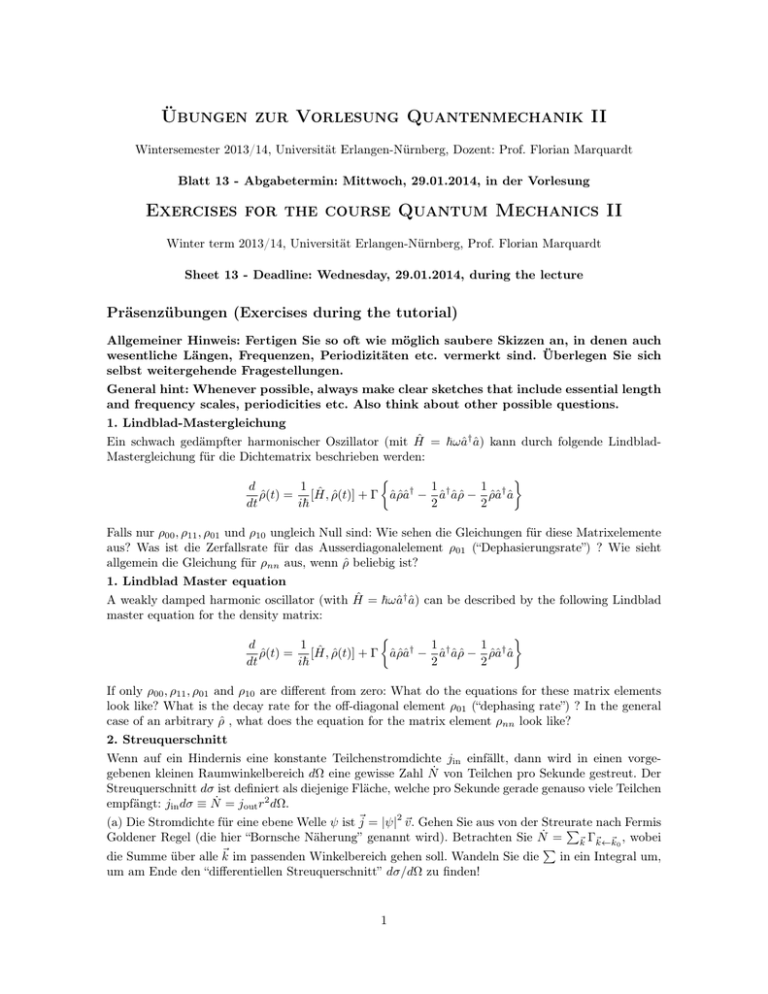
Übungen zur Vorlesung Quantenmechanik II Wintersemester 2013/14, Universität Erlangen-Nürnberg, Dozent: Prof. Florian Marquardt Blatt 13 - Abgabetermin: Mittwoch, 29.01.2014, in der Vorlesung Exercises for the course Quantum Mechanics II Winter term 2013/14, Universität Erlangen-Nürnberg, Prof. Florian Marquardt Sheet 13 - Deadline: Wednesday, 29.01.2014, during the lecture Präsenzübungen (Exercises during the tutorial) Allgemeiner Hinweis: Fertigen Sie so oft wie möglich saubere Skizzen an, in denen auch wesentliche Längen, Frequenzen, Periodizitäten etc. vermerkt sind. Überlegen Sie sich selbst weitergehende Fragestellungen. General hint: Whenever possible, always make clear sketches that include essential length and frequency scales, periodicities etc. Also think about other possible questions. 1. Lindblad-Mastergleichung Ein schwach gedämpfter harmonischer Oszillator (mit Ĥ = ~ω↠â) kann durch folgende LindbladMastergleichung für die Dichtematrix beschrieben werden: d 1 1 † 1 † † ρ̂(t) = [Ĥ, ρ̂(t)] + Γ âρ̂â − â âρ̂ − ρ̂â â dt i~ 2 2 Falls nur ρ00 , ρ11 , ρ01 und ρ10 ungleich Null sind: Wie sehen die Gleichungen für diese Matrixelemente aus? Was ist die Zerfallsrate für das Ausserdiagonalelement ρ01 (“Dephasierungsrate”) ? Wie sieht allgemein die Gleichung für ρnn aus, wenn ρ̂ beliebig ist? 1. Lindblad Master equation A weakly damped harmonic oscillator (with Ĥ = ~ω↠â) can be described by the following Lindblad master equation for the density matrix: d 1 1 1 ρ̂(t) = [Ĥ, ρ̂(t)] + Γ âρ̂↠− ↠âρ̂ − ρ̂↠â dt i~ 2 2 If only ρ00 , ρ11 , ρ01 and ρ10 are different from zero: What do the equations for these matrix elements look like? What is the decay rate for the off-diagonal element ρ01 (“dephasing rate”) ? In the general case of an arbitrary ρ̂ , what does the equation for the matrix element ρnn look like? 2. Streuquerschnitt Wenn auf ein Hindernis eine konstante Teilchenstromdichte jin einfällt, dann wird in einen vorgegebenen kleinen Raumwinkelbereich dΩ eine gewisse Zahl Ṅ von Teilchen pro Sekunde gestreut. Der Streuquerschnitt dσ ist definiert als diejenige Fläche, welche pro Sekunde gerade genauso viele Teilchen empfängt: jin dσ ≡ Ṅ = jout r2 dΩ. 2 (a) Die Stromdichte für eine ebene Welle ψ ist ~j = |ψ| ~v . Gehen Sie aus von der Streurate P nach Fermis Goldener Regel (die hier “Bornsche Näherung” genannt wird). Betrachten Sie Ṅ = ~k Γ~k←~k0 , wobei P die Summe über alle ~k im passenden Winkelbereich gehen soll. Wandeln Sie die in ein Integral um, um am Ende den “differentiellen Streuquerschnitt” dσ/dΩ zu finden! 1 (b) Falls Störungsrechnung nicht mehr anwendbar ist, kann man eine Lösung der zeitunabhängigen Schrödingergleichung betrachten, die aus einfallender ebener Welle und gestreuter Welle besteht. Im Fernfeld (weit vom Hindernis) sieht diese so aus: eikr ψ(~r) = ψ0 eikz + f (θ, ϕ) r θ und ϕ sind die üblichen sphärischen Winkelkoordinaten. Berechnen Sie wieder jin und jout , um dσ/dΩ zu finden! 2. Scattering cross section When a constant particle current density jin hits some obstacle, a certain number of particles per second Ṅ will be scattered into a given small solid angle dΩ. The scattering cross section dσ is defined as the surface through which the same number of particles pass per second: jin dσ ≡ Ṅ = jout r2 dΩ. 2 (a) The current density for a plane wave ψ is given by ~j = |ψ| ~v . Using the scattering rate asP calculated from Fermi’s Golden rule (called the Born approximation in this context), consider Ṅ = ~k Γ~k←~k0 , P where the sum over ~k runs over the applicable range of solid angles. Rewrite the sum as an integral in order to find the “differential cross section” dσ/dΩ. (b) If the scattering is so strong that perturbation theory breaks down, one may consider the trial solution for the time-dependent Schrödinger equation given below. It is constructed as a superposition of the incident plane wave and directional scattered waves. In the far field (away from the obstacle) it looks like: eikr ψ(~r) = ψ0 eikz + f (θ, ϕ) r where θ and ϕ are the usual spherical coordinates. Calculate jin and jout to again find dσ/dΩ. Hausaufgabe (Home work exercise) 3. Lineare Antwort eines harmonischen Oszillators Auf einen harmonischen Oszillator wirke eine Kraft F (t). Verwenden Sie die Kubo-Formel, um die Antwort hx̂(t)i zu berechnen. Sie werden sehen, dass das Ergebnis nicht von dem Zustand abhängt, in dem der Oszillator sich befindet. Vergleichen Sie das Ergebnis mit der Auslenkung x(t) eines klassischen Oszillators, der durch eine externe Kraft F (t) getrieben wird! Diese Beobachtung (sowie die Tatsache, dass das Resultat für beliebig starke Kräfte korrekt bleibt) ist eine Spezialität des harmonischen Oszillators. 3. Linear response for a harmonic oscillator Consider a harmonic oscillator subject to a time-dependent force F (t). Use the Kubo-formula to calculate the responsehx̂(t)i. You will find that the result does not depend on the state of the oscillator. Compare the result to the excursion x(t) of a classical oscillator that is driven by an external force F (t). The result you obtain (as well as the fact the result remains correct for an arbitrary force) is a special feature of the harmonic oscillator. 4. Präzession eines Spins Es sei ˆ~ Ĥ = ~bS (a) Leiten Sie für den Fall ~b = ωêz noch einmal explizit die Heisenberg-Bewegungsgleichung für Ŝx (t), Ŝy (t), und Ŝz (t) her. 2 (b) Lösen Sie die Gleichungen für Ŝx,y durch den Ansatz Ŝx (t) = cos ϕŜx (0) + sin ϕŜy (0) und Ŝy (t) = cos ϕŜy (0) − sin ϕŜx (0). (c) Was ist also eiθŜz /~ Ŝx e−iθŜz /~ ? 4. Spin precession Consider ˆ~ Ĥ = ~bS (a) Derive the Heisenberg equations of motion for Ŝx (t), Ŝy (t), and Ŝz (t) for the case in which ~b = ωêz . (b) Solve the equations for Ŝx,y using the Ansatz Ŝx (t) = cos ϕŜx (0) + sin ϕŜy (0) and Ŝy (t) = cos ϕŜy (0) − sin ϕŜx (0). (c) Evaluate eiθŜz /~ Ŝx e−iθŜz /~ . 3
